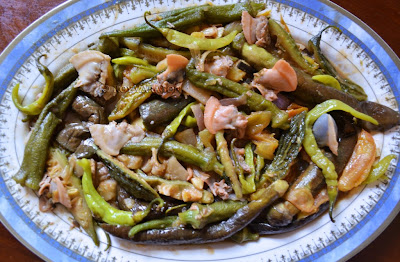 |
| Pinakbet nga addaan kaggo. |
Yet
another kaggo dish. And now with the ubiquitous but venerable pinakbet.
Instead of the usual meat such as pork with thick fat or that quintessential bagnet (also called chicharon, deeply fried pork shanks), or fish grilled or fried or
dried, let's try some shellfish. And kaggo,
being a large clam with a promising "meat" is one suitable
consideration for a sagpaw.
These are really humongous clams, you bet:
Open
the shells of the live kaggo and
shuck the meat out, save the tasty “digo”
for the pinakbet:
Cook the pinakbet as it is, instead of water, use the kaggo’s “broth” to dilute the bugguong, for a truly kaggo-flavored pinakbet. Put in the kaggo meat when all the veggies are about to be done, simmer for a few minutes, don’t overcook the kaggo so that it stays tender and succulent:
In
this pinakbet, besides tarong, paria, sili, okra and kamatis, I added bagas ti kamote (sweet potato) to thicken and sweeten the pakbet:
This
pinakbet is unique in that it has the
tastiness and kaggo-ness of the
popular brackish water clam. The flavor is enhanced by the sweetness of the
camote, a more Ilokano, and therefore more original taste, that is distinct
from that Tagalog pinakbet variation
which is soupy and infused with karabasa
(squash). An original Ilokano pinakbet has no karabasa in it. If it’s needed
to be sweetened, starchy tubers such as camote or taro (like rabok) or some yams (like balinghoy, tugi, ubi, kamangeg) are
added.
Come, let's eat, share with me this Ilokano gastronomic bliss:
:::::










































